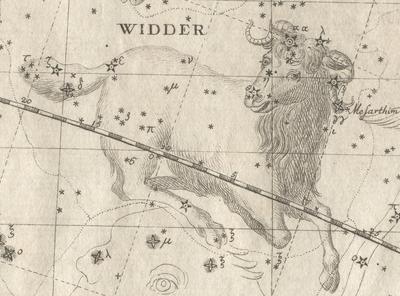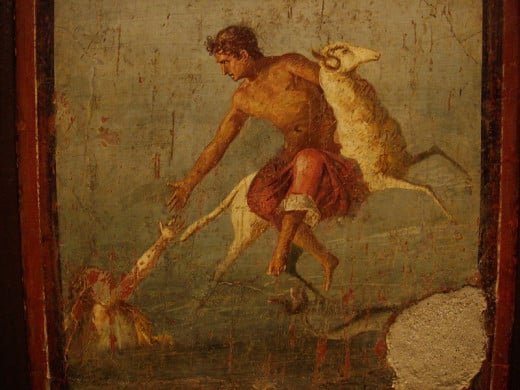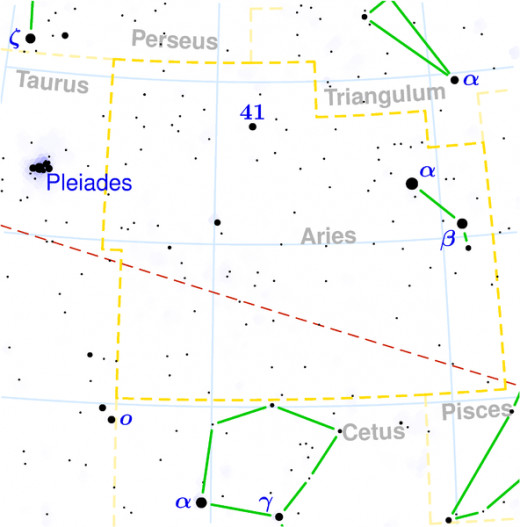The Constellation Aries: Stars and Mythology

The Many Names of Aries
The constellation we know as Aries has a long history and has gone by many names. In German it is called Widder, as seen in the illustration from the 1801 star atlas of the great astronomer Johann Bode. The Italians know it as Ariete, and the French call it le Beliér. In the old Anglo-Saxon language it was called Ramm, and in the language of the 12th century Anglo-Normans, Multuns. Chaucer and his contemporaries also use the name Ariete, an anglicization, also found in the Low Latin of the times. Among the star atlases of the middle ages and early modern periods a number reinterpreted the constellations as Biblical figures. In these Aries was reimagined as Abraham's Ram, which he found caught by the horns in a thicket and sacrificed to God in the place of Isaac, his son.
- Earliest Antiquity
It seems likely that Aries was first formed as a constellation by the very ancient Babylonians, where it was known not as a ram but as 'The Hired Laborer'. However, an inscription on The Tablet of the Thirty Stars shows another figure, the Scimitar, stretching from Pisces to Aries. The earliest references to Aries as a distinct constellation occur on boundary stones dated around the 14th century BC. It is not clear when the group became identified with a ram rather than a scimitar or farm worker. The confusion continues up to 1000 BC. Sources dated from this time show both representations.
- The Levantine Peoples
The peoples of the eastern end of the Mediterranean basin used a variety of distinct names. The Syrian peoples called the constellation Amru. The Persians knew it variously as Bara, Bere, or Berre. The later Turks used the term Kuzi.
In the Hebrew zodiac Aries is called Teli, and represents the tribes of Gad, Simeon or Naphtali. It is associated with the idea of liberation from slavery due to the fact that, according to the historian Josephus, the sun stood in this constellation when the Israelites were released from their bondage in Egypt.
- In the Muslim World
During the times of the great Caliphates, the Muslim peoples knew the constellation as Al-Hamal, the Sheep, although the term Al-Kabsh al-Alif, the Tame Ram, is also seen in some medieval sources. Hamal is the modern term. Muslim depictions of the star group generally followed the Greek depictions of a ram looking over its shoulder, but some sources differ, picturing a stag-like animal instead. Variations are also found in the number and specific stars included.
The 9th century astronomer Abu Ma'shar al-Balkhi held that the Creation occurred with the sun in the boundaries of Aries, an idea also shared by the Hellenistic-era Babylonian Berossus and the Roman Macrobius.

Classical Mythology
Aries is most commonly identified with the magical golden ram fashioned by Hermes upon which Phrixus and his sister Helle fled the kingdom of Thessaly to escape the deadly intentions of their jealous stepmother Ino. As the ram carried them speeding through the air, Helle disobeyed the god's instruction to not look down. She became dizzy and fell from the ram into the sea separating Greece and Asia Minor (modern Turkey), which became known in antiquity as the Hellespont (Helle's Sea). Upon reaching safety in the kingdom of Colchis on the far shores of the Black Sea, Phrixus somewhat ungratefully sacrificed the ram and gave the golden fleece to his benefactor, King Æetes. The king took the fleece and hung it in a sacred grove. There it remained until the voyage of Jason and the Argonauts.

The Modern Constellation
Aries is a relatively inconspicuous constellation, consisting of only three notable stars, none of which are particularly bright. It is located between Taurus to the east and Pisces to the west, with Perseus and Triangulum to the north and Cetus to the south. Occupying 441 square degrees of the sky, it is the 39th largest constellation. It can be seen from all northern latitudes and as far as 60° south. It is visible in the evenings of the autumn and winter, transiting the meridian at 9pm on December 10th.
Four notable galaxies are located within its boundaries, as well as five stars known to have planetary systems. None are visible to the naked eye.
The Major Stars of Aries
- α Arietis; a yellow second-magnitude star, spectral type K2, 85 light years away
This star is known as Hamal, the Arabic word for Sheep. Ancient Mesopotamian tablets use a variety of names: Dil-Kar, Proclaimer of the Dawn; Dil-Gan, Messenger of Light; Lu-Lim, the Ram's Eye; and Si-Mal, the Horn Star. The Assyrian name was Ailuv, the Prince, and the Hebrews called it Ayil, Leader of the Flock.
A number of Greek temples dated between 1580 and 360 BC were oriented to the rising point of this star.
- β Arietis, a white star of magnitude 2.6, spectral type A5, 46 light years away
The common name of this star is Sheratan, which is the plural form of the Arabic Al-Sharat, meaning 'signs'. A rarer form, Sartai, is a derivative of this term. This name is plural because the term originally referred to this star and γ Arietis. This pair were commonly associated throughout history. In India they were known as the Ashwins, or The Two Horsemen, a pair of legendary twins from the epic Mahabharata. In Persia they were called Padevar, The Protectors, which is also the meaning of the Sogdian name Bashish.
- γ Arietis, binary star, bluish white and silver, magnitudes 4.5 and 5, spectral type A0, 115 light years away
The present name of this star is Mesarthim, a mistranslation of the Hebrew term for 'ministers'. The dual nature of this star was one of the discoveries of the English scientist Dr. Robert Hooke. He found this while tracking a comet in 1664, and recorded it in his journal as "a like instance to which I have not else met in all the Heaven."
Together with α and β this star formed the ancient Hebrew constellation Shalish, depicting a triangular musical instrument. These three stars also comprised one of the Arabic groupings known as Athafiyya, which represented an arrangement of three stones upon which was placed a nomad's cooking pot. The others are located in the modern constellations of Lyra, Orion, Musca, and Draco.
- δ Arietis, a white star of magnitude 4.4, spectral type K2, 255 light years away
The name of this star is Botein, an Arabic word meaning 'belly', probably referring to its position in the star maps of earlier times. In modern depictions the star lies near the ram's tail.
- 41 Arietis, a binary star of magnitude 3.6, spectral type B8, 160 light years distant
This star is known as Bharani, the name of the second lunar mansion in the Hindu astrology. Though it is brighter than some of the other components of Aries, it does not possess a greek letter designation. This is because at the time of the compilation of the great star atlases the star was not part of Aries, but rather of the now-defunct constellation Musca Borealis.
You May Also Like:
- The Constellation Auriga: Stars and Mythology
Auriga is a prominent constellation in the northern sky. Depicted as a young man in a chariot carrying a bag of baby goats, its origin is unclear. - The Constellation Bootes: Stars and Mythology
The ancient constellation of Boötes appears in the far northern skies. Depicted as hunter or plowman, the constellation has figured in the literature and mythology of ancient cultures.








